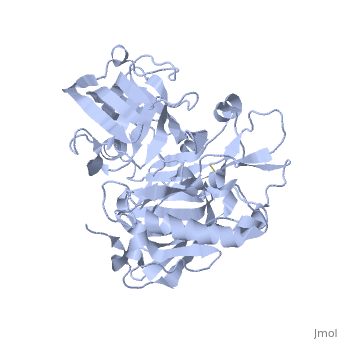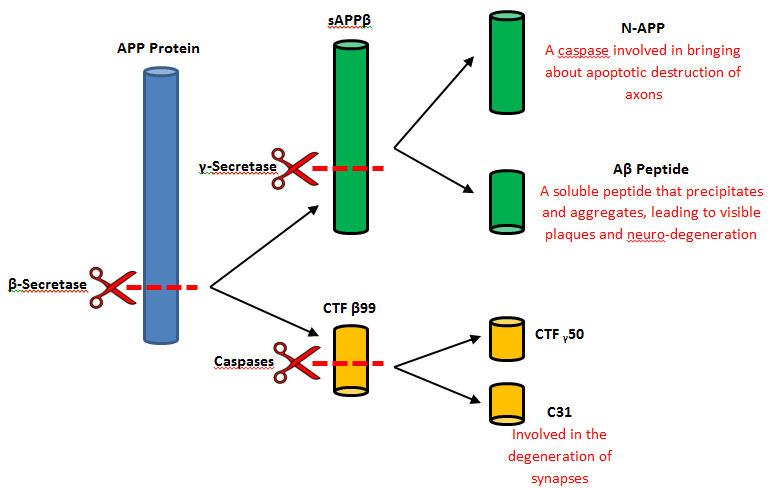Beta Secretase (BACE1) 1SGZ
From Proteopedia
| Line 41: | Line 41: | ||
[[Image:CleavageOfBSecretase.jpg]] <ref>JCSciphile, March - Beta-Secretase, 2014, Web, Retrieved April 5, 2016 from http://jcsciphile.com/molecule-of-the-month/march-beta-secretase/</ref>. | [[Image:CleavageOfBSecretase.jpg]] <ref>JCSciphile, March - Beta-Secretase, 2014, Web, Retrieved April 5, 2016 from http://jcsciphile.com/molecule-of-the-month/march-beta-secretase/</ref>. | ||
| - | In a general reaction, APP is initially cleaved by alpha-secretase in a certain position every time and then by gamma-secretase. Neurons may benefits from the released fragments produced by the alpha-secretase and gamma-secretase cleavage of APP <ref name="nine"> Golub, M. (Producer) & Golub, M. (Director). (2015). Youtube. United States: University of Rochester Introductory Biochemistry </ref>. However, when beta-secretase enters the equation the cleavage of APP changes positions. Once gamma-secretase has officially completed its cleavage, amyloid-beta is released into the extracellular membrane space. Amyloid-beta is most commonly found to aggregate in this area and form plaques that are extremely harmful to the human body. It is thought that this plaque build up is the initial cause of Alzheimer’s | + | In a general reaction, APP is initially cleaved by alpha-secretase in a certain position every time and then by gamma-secretase. Neurons may benefits from the released fragments produced by the alpha-secretase and gamma-secretase cleavage of APP <ref name="nine"> Golub, M. (Producer) & Golub, M. (Director). (2015). Youtube. United States: University of Rochester Introductory Biochemistry </ref>. However, when beta-secretase enters the equation the cleavage of APP changes positions. Once gamma-secretase has officially completed its cleavage, amyloid-beta is released into the extracellular membrane space. Amyloid-beta is most commonly found to aggregate in this area and form plaques that are extremely harmful to the human body. It is thought that this plaque build up is the initial cause of Alzheimer’s disease in the brain <ref name="ten">Manada, N., Tanokashira, D., Hoska, A., Kametani, F., Tamoka, A,. and Araki, W. (2015). Amyloid beta-protein oligomers upregulate the beta-secretase, BACE1, through a post-translational mechanism involving its altered subcellular distribution in neurons. Molecular Brain, Vol. 8, p.1-12. 12p. doi: 10.1186/s13041-015-0163-5</ref>. |
== Associated Health Conditions == | == Associated Health Conditions == | ||
Revision as of 03:57, 14 April 2016
Beta-secretase, also known as BACE or Memapsin 2, is encoded by the gene BACE1. Beta-secretase is a proteolytic, transmembrane enzyme with two active sites on the extracellular region. It is associated with processing amyloid precursor protein (APP), which is an integral membrane protein.[1] A malfunction in the processing of APP results in the formation of the peptide amyloid beta. Amyloid-beta is a neurotoxic peptide segment that aggregates into plaques. These plaques are the primary component of plaques found in individuals with Alzheimers Disease. [2] Other biological associations of this enzyme include modulating myelination in the central and peripheral nervous systems.[3]
Enzyme Class
Beta-secretase is an enzyme that is classified as a class 3 enzyme, which are hydrolases [4]. The enzyme acts on breaking peptide bonds and therefore is also considered a peptidase and belongs to the subclass of aspartic acid endopeptidases.[5]
Structure
| |||||||||||
References
- ↑ Ghosh, A.; Kumaragurubaran, N.; Hong, L.; Koelsh, G.; Tang, J. Memapsin 2 (Beta-Secretase) Inhibitors: Drug Development. CAR Current Alzheimer Research. [Online] 2008, 5, 121–131. http://jamesmadisonva.library.ingentaconnect.com/content/ben/car/2008/00000005/00000002/art00004
- ↑ 2.0 2.1 2.2 John, V.; Beck, J. P.; Bienkowski, M. J.; Sinha, S.; Heinrikson, R. L. Human β-Secretase (BACE) And BACE Inhibitors. ChemInform. [Online] 2004, 35, 4625-4630. http://pubs.acs.org/doi/pdf/10.1021/jm030247h
- ↑ Hu, X.; Hicks, C. W.; He, W.; Wong, P.; Macklin, W. B.; Trapp, B. D.; Yan, R. Bace1 Modulates Myelination in the Central and Peripheral Nervous System. Nature Neuroscience Nat Neurosci. [Online] 2006, 9, 1520–1525. http://www.nature.com/neuro/journal/v9/n12/abs/nn1797.html
- ↑ Nomenclature Committee of the International Union of Biochemistry and Molecular Biology. The Enzyme List Class 3 — Hydrolases. http://www.enzyme-database.org/downloads/ec3.pdf
- ↑ DBGET Search. KEGG ENZYME: 3.4.23.46. http://www.genome.jp/dbget-bin/www_bget?ec:3.4.23.46
- ↑ 6.0 6.1 6.2 Venugopal, C.; Demos, C. M.; Rao, K. S. J.; Pappolla, M. A.; Sambamurti, K. Beta-secretase: Structure, Function, and Evolution. CNS & Neurological Disorders Drug Targets. [Online] 2008. 7(3), 278–294. http://www.ncbi.nlm.nih.gov/pmc/articles/PMC2921875/
- ↑ 7.0 7.1 7.2 Shimizu, H.; Tosaki, A.; Kaneko, K.; Hisano, T.; Sakurai, T.; Nukina, N. Crystal Structure of an Active Form of BACE1, an Enzyme Responsible for Amyloid Beta Protein Production. Molecular and Cellular Biology [Online] 2008, 28(11), 3663-671. http://mcb.asm.org/content/28/11/3663.full.pdf+html
- ↑ Kumalo, M.; Soumendranath B.; Soliman, M. E. Investigation of Flap Flexibility of β-secretase Using Molecular Dynamic Simulations. Journal of Biomolecular Structure and Dynamics [Online] , 2015, 1-12. http://www.tandfonline.com/doi/full/10.1080/07391102.2015.1064831
- ↑ 9.0 9.1 9.2 Golub, M. (Producer) & Golub, M. (Director). (2015). Youtube. United States: University of Rochester Introductory Biochemistry
- ↑ 10.0 10.1 Manada, N., Tanokashira, D., Hoska, A., Kametani, F., Tamoka, A,. and Araki, W. (2015). Amyloid beta-protein oligomers upregulate the beta-secretase, BACE1, through a post-translational mechanism involving its altered subcellular distribution in neurons. Molecular Brain, Vol. 8, p.1-12. 12p. doi: 10.1186/s13041-015-0163-5
- ↑ Sugana, K., Padlan E., Smith, C., Carlson, W., and Davis, D. (1987). Retrieved April 5, 2016 from

- ↑ JCSciphile, March - Beta-Secretase, 2014, Web, Retrieved April 5, 2016 from http://jcsciphile.com/molecule-of-the-month/march-beta-secretase/
- ↑ Vasser, R. The B-Secretase Enzyme in Alzheimer’s Disease. Journal of Molecular Neurosceince. 2004, 23, 105-113. http://link.springer.com/article/10.1385/JMN:23:1-2:105
- ↑ Shoji, M.; Golde, T.; Ghiso, J.; Cheung, T.; Estus, S.; Shaffer, L.; Cai, X.; Mckay, D.; Tintner, R.; Frangione, B.; Et, A. Production Of the Alzheimer Amyloid-beta Protein by Normal Proteolytic Processing. Science. 1992, 258, 126–129.
- ↑ AnaSpec. Amyloid Peptides. Peptides, http://www.anaspec.com/products/productcategory.asp?id=1
- ↑ Thompson, L.; Bronson, J.; Zusi, C.; Progress in the discovery of BACE Inhibitors. Current Pharmaceutical design. 2005, 11, 3383-3404
- ↑ 17.0 17.1 Ghosh, A. K.; Brindisi, M.; Tang, J. Developing β-Secretase Inhibitors for Treatment of Alzheimer’s Disease. Journal of Neurochemistry. [Online] 2011, 120, 71–83.http://onlinelibrary.wiley.com/doi/10.1111/j.1471-4159.2011.07476.x/full



